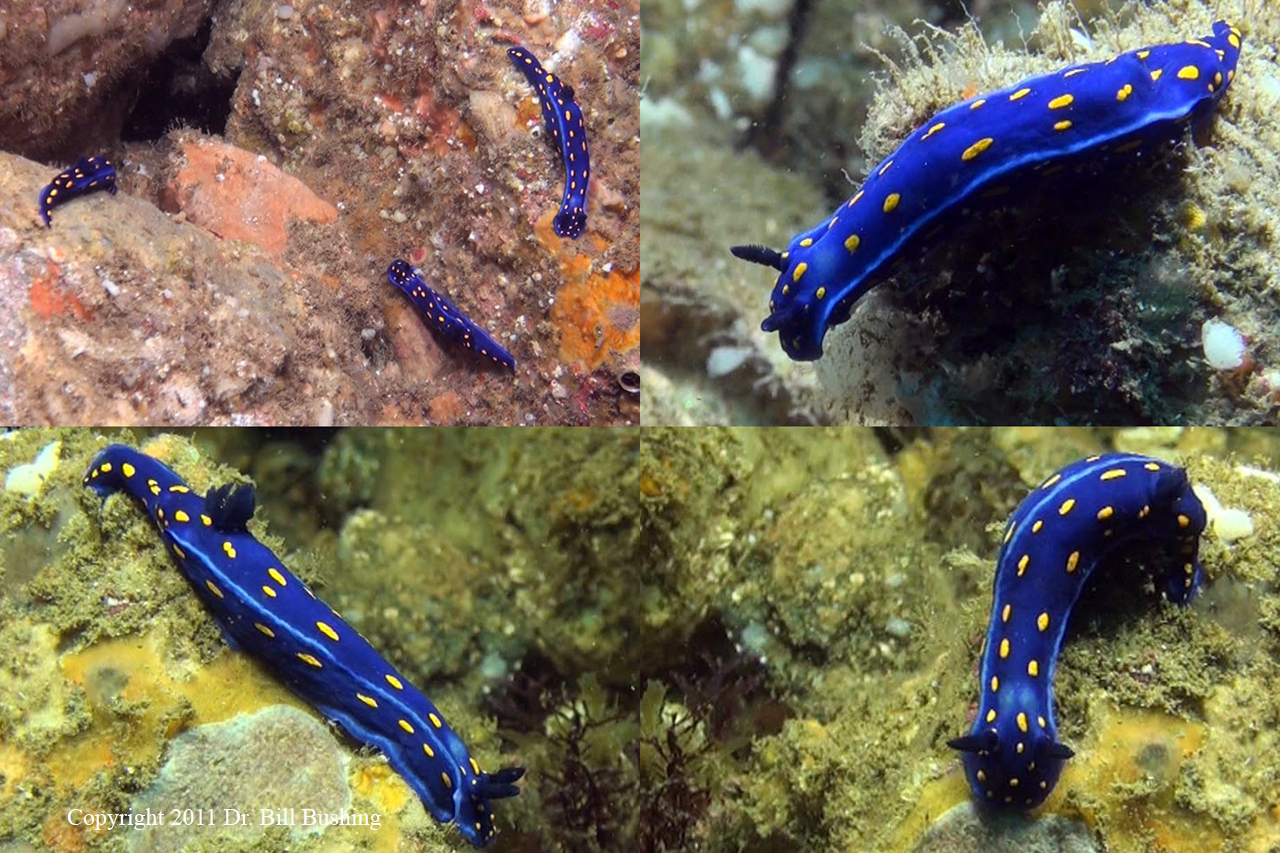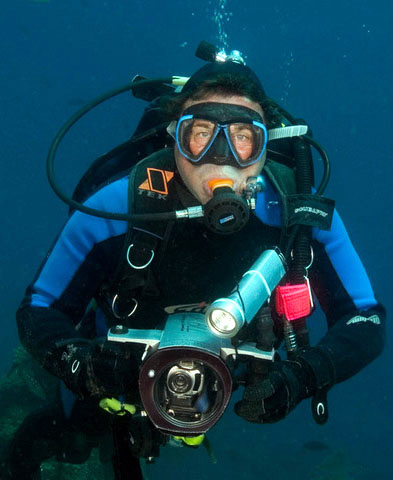 |
Hypselodoris californiensis
Image courtesy of Dr. Bill BushingThree Hypselodoris californiensis in a single frame (upper left) and several others from the dive park last week
Casino Point Dive Park, Santa Catalina Island, California
. Copyright 2011, Dr. Bill Bushing
Hypselodoris californiensis (Bergh, 1879)
DIVE DRY WITH DR. BILL #448: HIPS ALA DORIS
No, my dear readers. This is not a column about a lovely lady named Doris with a beautiful figure (although that would certainly be in line with some of my writings!). However, the subject of this week's "Dive Dry" episode is indeed very, very beautiful... if you are fond of sea slugs like I am. I'm referring to the shell-less snails known as nudibranchs which often come in beautiful colors. Many underwater photographers and divers in general "focus" on these gorgeous gastropods.
Recently I was asked by a few divers in the park about a beautiful dark blue slug with rows of bright yellow spots. From that description alone, I knew it had to be Hypselodoris californiensis (Bill Rudman's Sea Slug Forum). I have only seen this nudibranch a few times in my many decades of diving, but it is a very striking species and one you don't easily forget once you see it. The dark blue body with its vivid rows of yellow spots is often edged in lighter cobalt blue, making it a delight for underwater photographers and videographers to capture on film... er, digital memory cards. The gills, located towards the rear of the dorsal surface, and the sensory rhinophores at the front are either blue or black. Biologists believe the strikingly beautiful colors of nudibranchs serve as a warning to potential predators. These sea slugs are said to have a nasty taste, although I wonder if it could be half as bad as my cooking.
On a beautiful Friday afternoon, I entered the water to spend an hour or more in what I refer to as "the Kelp Cathedral." This is the region between the inner edge of the kelp forest and the Casino groyne (breakwater) from just past the Cousteau memorial plaque to the harbor mouth. I absolutely love the beauty of this area and it is rich with critters to film as well. As I poked around in the shallows, looking in every nook and cranny, I came upon three of these nudies on a single rock. I was in Hypselodoris heaven in the Kelp Cathedral! My high definition camcorder began rolling with the nudies beautifully illuminated by my new LED video lights.
Although not seen often, Hypselodoris californiensis is known from Monterey to Punta Eugenia, Baja California. Perhaps because it is fairly rare, few seem to know a common name. Two of the most authoritative web sites on sea slugs don't list one. I have heard this species referred to as the California blue doris. The three I saw were rather slender compared to others. Individuals may reach lengths of 3 1/2 inches. The following day I located another one and filmed it, too.
Dave Behrens of Slugsite states that this nudibranch seems to be declining in "abundance" in southern California. The genus Hypselodoris is more typical of subtropical and tropical environments than temperate kelp forests. Perhaps we will see a resurgence of it as our waters appear to be warming fast this summer... and global climate change may make that a "permanent" (at least within a human lifespan) trend in the future.
We humans think of critters like lions and tigers and great white sharks as "vicious" predators. Of course all they are doing is "munching," a very critical behavior for the survival of the individual so they may grow and mature to perform the other critical behavior of "mating" to ensure the species itself continues. We would hardly consider a sea slug to be in that category, especially since many associate slugs with a vegetarian or vegan dietary preference. However, to the small invertebrates that these nudibranchs munch on, they are indeed vicious predators! Some nudies feed on relatives of the jellyfish including hydroids and sea anemones, and then incorporate their stinging cells into their own bodies as another line of defense. However, Hypselodoris feeds on sponges which are extremely primitive invertebrates. I doubt they are very cognizant of becoming dinner.
Nudibranchs come in two common forms, the dorids and the aeolids. One of the easily recognizable differences in the placement of the cerata or gills on the body. Dorids like Hypselodoris have their gills in a cluster towards the rear of the body. This cluster is retractible into the body to protect it from curious carnivores. The aeolids have their cerata scattered all over their dorsal surface. In fact, at least one species looks like a shag carpet. When I finally grow my gills, and no longer have to pay for air fills, I'm not sure where I'll place them They would be such a joy, allowing me to dive all day! At least I improved my dive times recently by replacing the leaking BCD inflater and hose with another one. I now get 25-30% more time underwater than I did before! As an added benefit, other divers can't see the stream of bubbles that was emanating from the inflater, making it harder to find me and intrude on my filming!
For you video fans, a short Flash video (Adobe Media Player) has been prepared of my encounter
with
Hypselodoris californiensis .
Dr. Bill Bushing
STAR THROWER EDUCATIONAL MULTIMEDIA (STEM)
"Dive Dry with Dr. Bill" newspaper column and cable TV show
Marine Biological Research and
Environmental Education through Video,
the Internet, RS-GIS, and Photography
P. O. Box 849
107 Tremont Avenue
Avalon, Santa Catalina Island, CA 90704
bushing@post.harvard.edu
http://www.StarThrower.org
**************************************************
Dr. Bill Bushing on location at Casino Point Dive Park
 |
Dr. Bill Bushing first used SCUBA in the winter of 1961-62, has logged thousands of dives and has been a marine educator and biologist for many decades. He has lived on Catalina since graduating from Harvard in 1969. Dr. Bill's primary scientific research is on kelp forest ecology, the dispersal of marine invertebrates and marine reserve design. He also writes a weekly newspaper column ("Dive Dry with Dr. Bill"), has produced 22 educational DVDs and two cable TV shows on the marine life of kelp forests. Through the years he has had the pleasure of working and diving with the likes of Jacques and Jean Michel Cousteau, Dr. Richard Murphy, Dr. Sylvia Earl, Dr. Milton Love, Dr. Guy Harvey and Wyland. His web site is www.starthrower.org.
Send Dr. Bushing email at bushing@post.harvard.edu |
